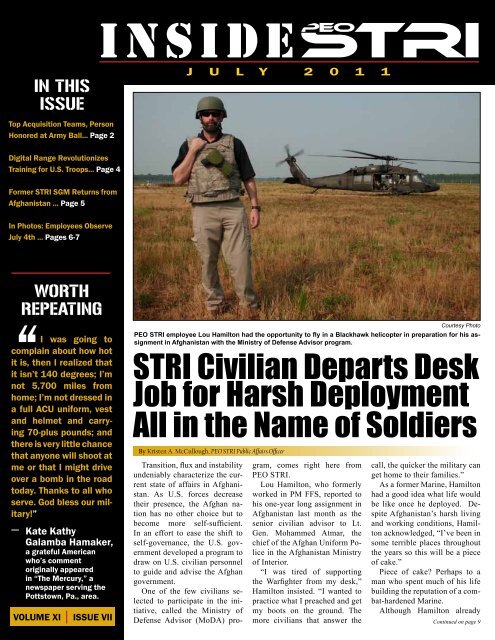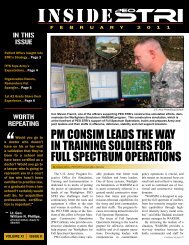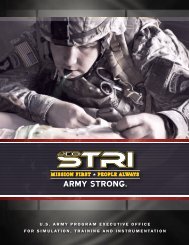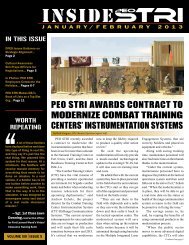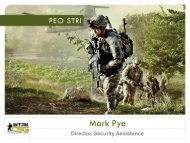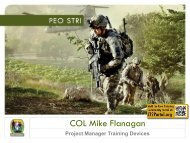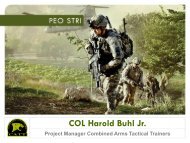InsIde - PEO STRI - U.S. Army
InsIde - PEO STRI - U.S. Army
InsIde - PEO STRI - U.S. Army
Create successful ePaper yourself
Turn your PDF publications into a flip-book with our unique Google optimized e-Paper software.
Inside<br />
In this<br />
Issue<br />
Top Acquisition Teams, Person<br />
Honored at <strong>Army</strong> Ball... Page 2<br />
j u l y 2 0 1 1<br />
Digital Range Revolutionizes<br />
Training for U.S. Troops... Page 4<br />
Former <strong>STRI</strong> SGM Returns from<br />
Afghanistan ... Page 5<br />
In Photos: Employees Observe<br />
July 4th ... Pages 6-7<br />
Worth<br />
Repeating<br />
I was going to<br />
complain about how hot<br />
it is, then I realized that<br />
it isn’t 140 degrees; I’m<br />
not 5,700 miles from<br />
home; I’m not dressed in<br />
a full ACU uniform, vest<br />
and helmet and carrying<br />
70-plus pounds; and<br />
there is very little chance<br />
that anyone will shoot at<br />
me or that I might drive<br />
over a bomb in the road<br />
today. Thanks to all who<br />
serve. God bless our military!”<br />
Kate Kathy<br />
Galamba Hamaker,<br />
a grateful American<br />
who’s comment<br />
originally appeared<br />
in “The Mercury,” a<br />
newspaper serving the<br />
Pottstown, Pa., area.<br />
VOLUME XI<br />
ISSUE VII<br />
By Kristen A. McCullough, <strong>PEO</strong> <strong>STRI</strong> Public Affairs Officer<br />
Courtesy Photo<br />
<strong>PEO</strong> <strong>STRI</strong> employee Lou Hamilton had the opportunity to fly in a Blackhawk helicopter in preparation for his assignment<br />
in Afghanistan with the Ministry of Defense Advisor program.<br />
<strong>STRI</strong> Civilian Departs Desk<br />
Job for Harsh Deployment<br />
All in the Name of Soldiers<br />
Transition, flux and instability<br />
undeniably characterize the current<br />
state of affairs in Afghanistan.<br />
As U.S. forces decrease<br />
their presence, the Afghan nation<br />
has no other choice but to<br />
become more self-sufficient.<br />
In an effort to ease the shift to<br />
self-governance, the U.S. government<br />
developed a program to<br />
draw on U.S. civilian personnel<br />
to guide and advise the Afghan<br />
government.<br />
One of the few civilians selected<br />
to participate in the initiative,<br />
called the Ministry of<br />
Defense Advisor (MoDA) program,<br />
comes right here from<br />
<strong>PEO</strong> <strong>STRI</strong>.<br />
Lou Hamilton, who formerly<br />
worked in PM FFS, reported to<br />
his one-year long assignment in<br />
Afghanistan last month as the<br />
senior civilian advisor to Lt.<br />
Gen. Mohammed Atmar, the<br />
chief of the Afghan Uniform Police<br />
in the Afghanistan Ministry<br />
of Interior.<br />
“I was tired of supporting<br />
the Warfighter from my desk,”<br />
Hamilton insisted. “I wanted to<br />
practice what I preached and get<br />
my boots on the ground. The<br />
more civilians that answer the<br />
call, the quicker the military can<br />
get home to their families.”<br />
As a former Marine, Hamilton<br />
had a good idea what life would<br />
be like once he deployed. Despite<br />
Afghanistan’s harsh living<br />
and working conditions, Hamilton<br />
acknowledged, “I’ve been in<br />
some terrible places throughout<br />
the years so this will be a piece<br />
of cake.”<br />
Piece of cake? Perhaps to a<br />
man who spent much of his life<br />
building the reputation of a combat-hardened<br />
Marine.<br />
Although Hamilton already<br />
Continued on page 9
<strong>Army</strong> Ball Awards Recognize<br />
<strong>PEO</strong> <strong>STRI</strong>’s Top Achievers<br />
U.S. <strong>Army</strong> Photo/Doug Schaub U.S. <strong>Army</strong> Photo/Doug Schaub U.S. <strong>Army</strong> Photo/Doug Schaub<br />
The Acquisition Person of the Year award was<br />
presented to Joe Cabret by Dr. Jim Blake at the<br />
236th <strong>Army</strong> Birthday Ball June 18.<br />
By Megan Jeffers, <strong>PEO</strong> <strong>STRI</strong> External Affairs Specialist<br />
On behalf of PM Field OPS, the program manager<br />
Russ McBride accepts the STAR award for<br />
contract execution at the June 18 <strong>Army</strong> Ball.<br />
Lt. Col. Charles Worshim of PM TRADE’s Combat<br />
Training Instrumentation Systems accepts<br />
the STAR award for project execution during<br />
the annual <strong>Army</strong> Birthday Ball June 18.<br />
The annual announcement of<br />
<strong>PEO</strong> <strong>STRI</strong>’s Acquisition Person<br />
of the Year and STAR award recipients<br />
routinely draws keen interest<br />
from the local <strong>Army</strong> Birthday<br />
Ball attendees. This year’s<br />
awards were presented in front<br />
of a 1,100-plus crowd by Dr.<br />
Jim Blake, <strong>PEO</strong> <strong>STRI</strong>’s program<br />
executive officer, at the June 18<br />
gala.<br />
The event’s co-host, the Association<br />
of the United States<br />
<strong>Army</strong> (AUSA) Sunshine Chapter,<br />
recognized Joe Cabret as <strong>PEO</strong><br />
<strong>STRI</strong>’s acquisition person of the<br />
year.<br />
The award represents individuals<br />
who have made significant<br />
contributions to the U.S. <strong>Army</strong><br />
through their acquisition responsibilities<br />
and duties. This year, it<br />
was presented to Cabret who is the<br />
lead project director for PM Field<br />
OPS’ Soldier Systems Gunnery,<br />
Maintenance and Driver TADSS<br />
for successfully relocating more<br />
than 150 training devices in support<br />
of the Defense Base Closure<br />
and Realignment Act.<br />
The project required the development<br />
of an operational plan<br />
that provided detailed instructions<br />
to assist the Warfighter FO-<br />
CUS contractor in understanding<br />
movement procedures of training<br />
devices at several <strong>Army</strong> installations,<br />
site walk-throughs, 100<br />
percent government-furnished<br />
property inventories, and identification<br />
and segregation of key<br />
equipment to include disposal,<br />
equipment preparation, movement<br />
coordination and loading,<br />
Cabret said.<br />
“I’m honored to be recognized<br />
by the <strong>PEO</strong> <strong>STRI</strong> leadership,”<br />
he continued. “I appreciate the<br />
recognition and will continue to<br />
do the best I can in support of<br />
the <strong>PEO</strong> <strong>STRI</strong> mission and the<br />
Warfighter.”<br />
In addition to the Acquisition<br />
Person of the Year award, recognition<br />
was given to two <strong>PEO</strong><br />
<strong>STRI</strong> STAR teams—one for contract<br />
execution and another for<br />
project execution.<br />
Russ McBride, project manager<br />
for PM Field OPS, accepted<br />
the award for contract execution<br />
on behalf of his team for PM<br />
Field OPS’ work on the Afghan<br />
National Air Force Pilot Training<br />
Source Selection Team. The<br />
team was comprised of Elizabeth<br />
Owen, Tony Pham, Gloria Bailey<br />
and Linda Comfort.<br />
As described in the team’s<br />
award nomination written by<br />
teammate Linda Comfort, the<br />
team’s acquisition strategy and<br />
source selection approach sought<br />
to achieve a comprehensive, bestvalue<br />
training package focused<br />
on student success of the Afghan<br />
military pilots, cost reduction and<br />
reduced delivery time. The approach<br />
incorporated innovative<br />
solutions and delivered a competitive<br />
training solution that embraced<br />
the tenents of better buying<br />
power and will provide the<br />
optimal environment for Afghan<br />
student pilot performance.<br />
The contract award was made<br />
for a period of three years with<br />
flexibility to train 80 pilots on a<br />
compressed, staggered schedule.<br />
The unique tailoring of a commercial<br />
item to fit the complex<br />
requirements and constraints of<br />
training Afghan military pilots<br />
outside of their native land is<br />
noteworthy, the nomination stated.<br />
“It’s always nice to have good<br />
teamwork recognized,” teammate<br />
Elizabeth Owen said. “[This project]<br />
demonstrates <strong>STRI</strong>’s ability<br />
to be both creative and proactive<br />
when contracting resources are in<br />
demand.”<br />
The second STAR award for<br />
project execution was presented<br />
to PM TRADE’s Interim Soldier<br />
Tracking System team and accepted<br />
by Lt. Col. Charles Worshim.<br />
2<br />
Inside <strong>STRI</strong> JUly 2011
New Training Device Can Counter Taliban<br />
Threat to <strong>Army</strong> Aviators in Afghanistan<br />
By Rick Gregory, A<strong>PEO</strong> Business Operations Support Staff<br />
Surface-to-air missiles (SAMs)<br />
used by mujahedeen fighters in<br />
Afghanistan in the 1980s played<br />
a crucial role in the defeat of the<br />
Soviet forces, according to an article<br />
published in the Washington<br />
Examiner last October. It is estimated<br />
the mujahedeen took down<br />
269 Soviet aircraft during the war.<br />
That threat has been renewed, but<br />
this time against U.S. aviators, the<br />
newspaper reported.<br />
“Iranian military advisors have<br />
been training Taliban fighters in<br />
Afghanistan on the use of surfaceto-air<br />
missiles, a potential game<br />
changer in the current conflict if<br />
insurgents can use such weapons<br />
effectively, several current and<br />
retired military officials said,” the<br />
article stated. Coalition forces are<br />
even more dependent on moving<br />
troops and supplies through the<br />
air than the Red <strong>Army</strong> was due to<br />
the threat posed on the ground by<br />
IEDs, experts added.<br />
If the old standard that “timing<br />
is everything” is true, it certainly<br />
applies here.<br />
In April, <strong>PEO</strong> <strong>STRI</strong>’s PM<br />
TRADE awarded a contract for<br />
a Man-Portable Aircraft Survivability<br />
Trainer (MAST) that will<br />
train rotary wing helicopter pilots<br />
on evading surface-to-air missile<br />
threats. The MAST system will<br />
accurately represent a SAM being<br />
fired to include the visual smoke<br />
plume it emits.<br />
“I am really excited that <strong>PEO</strong><br />
<strong>STRI</strong> is procuring this potentially<br />
life-saving training device<br />
for our <strong>Army</strong> aviators,” said Dr.<br />
Jim Blake, the program executive<br />
officer for <strong>PEO</strong> <strong>STRI</strong> and a<br />
former <strong>Army</strong> aviator. “It provides<br />
aviators the most realistic training<br />
they can undergo to help them<br />
survive a lethal surface-to-air<br />
missile attack.”<br />
Weighing less than 35 pounds,<br />
the shoulder-fired MAST incorporates<br />
a light-emitting diode<br />
ultraviolet emitter that replicates<br />
the effects of an actual threat.<br />
The system will stimulate the<br />
aircraft’s common missile warning<br />
system and give the aircrew<br />
all the indications of a real world<br />
surface-to-air missile attack. The<br />
MAST can activate the indicators<br />
from distances up to more than<br />
three miles.<br />
When used during live training<br />
exercises, the MAST can simulate<br />
a SAM engagement sequence<br />
including seeker lock (the missile<br />
locking onto the target) and<br />
break lock (causing the missile<br />
to move sharply away from the<br />
target aircraft). Additionally, the<br />
MAST provides comprehensive<br />
after-action video for debriefing<br />
crews and providing continuing<br />
pilot skills training.<br />
After extensive research and<br />
evaluation by the Joint Forces<br />
Command and <strong>PEO</strong><br />
Intelligence, Electronic<br />
Warfare and<br />
Sensors, in 2009<br />
<strong>PEO</strong> <strong>STRI</strong>’s PM<br />
TRADE became<br />
responsible for the<br />
procurement of the<br />
MAST system.<br />
“We are very<br />
pleased to be just<br />
months away from<br />
getting the MAST to<br />
the field to enhance<br />
the training of our<br />
aviators to increase<br />
their survivability<br />
during overseas<br />
contingency operations,”<br />
said Col.<br />
Mike Flanagan, project<br />
manager for PM<br />
TRADE. “From the simulated<br />
missile locking onto the aircraft<br />
and activating the warning system<br />
to the visual effect of the smoke<br />
flume, the pilots will feel the<br />
same adrenaline rush in training<br />
that they will feel during an actual<br />
SAM attack. Now that’s a great<br />
live training solution to fulfill a<br />
critical need for our aviators!”<br />
The current MAST fielding<br />
plan calls for 100 systems by<br />
2016, with an initial delivery of<br />
32 MASTs in 2012 to Forts Irwin,<br />
Hood, Campbell, Polk and<br />
Rucker and units in Germany and<br />
South Korea.<br />
Photo courtesy of AAI Corporation<br />
The Man-Portable Aircraft Survivability Trainer (MAST), which weighs less<br />
than 35 pounds, can stimulate an aircraft’s common missile warning system<br />
from more than three miles away.<br />
U.S. <strong>Army</strong> Photo<br />
Helicopter pilots will learn how to react to surface-to-air missile threats<br />
during live training exercises when the Man-Portable Aircraft Survivability<br />
Trainer (MAST) is deployed to the field.<br />
Inside <strong>STRI</strong> JUly 2011 3
<strong>PEO</strong> <strong>STRI</strong> Introduces Armor, Infantry<br />
Units in Korea to Digital Ranges<br />
By Rick Gregory, A<strong>PEO</strong> Business Operations Support Staff<br />
The 2nd Infantry Division’s<br />
(2ID) motto is “Second to None,”<br />
and thanks to collaboration with<br />
<strong>PEO</strong> <strong>STRI</strong>, the division’s commanding<br />
general said he feels that<br />
motto now also applies to the live<br />
fire complex his Soldiers train on.<br />
For many years, Soldiers assigned<br />
to 2ID in Korea have become<br />
intimately familiar with the<br />
Rodriguez Live Fire Complex<br />
(RLFC) as they went through<br />
their qualifications during livefire<br />
training.<br />
While the RLFC’s non-digital<br />
Multi-Purpose Training Range<br />
provided valuable live-fire exercises<br />
for 2ID Soldiers over the<br />
years, the division’s leader, Maj.<br />
Gen. Michael Tucker, knew the<br />
digital applications available for<br />
the RLFC would provide his Soldiers<br />
with a better live-fire training<br />
environment.<br />
Acting on his request, <strong>PEO</strong><br />
<strong>STRI</strong> updated the existing range<br />
with digital capabilities and fielded<br />
a Digital Multi-Purpose Range<br />
Complex (DMPRC) within eight<br />
months after the contract was<br />
awarded. Following the Acceptance<br />
Testing and achieving Initial<br />
Operating Capability, units of<br />
the division were conducting livefire<br />
tank gunnery training the next<br />
day. A combined arms live-fire<br />
exercise with infantry and armor<br />
units was successfully completed<br />
just weeks later.<br />
Tucker said he was so pleased<br />
with the transition to the modernized<br />
live-fire range that he intends<br />
to showcase the cutting-edge digital<br />
capabilities to the Republic of<br />
Korea senior military leadership<br />
later this year.<br />
“This is the most modern mission-focused<br />
precision gunnery<br />
complex in the world,” Tucker<br />
said. “The unique combination<br />
of range technology and terrain<br />
allows units to train as they will<br />
fight and where they will fight if<br />
called on to defend the Republic<br />
of Korea from aggression,” Tucker<br />
said.<br />
The Digital Range Training<br />
System (DRTS), which is at the<br />
heart of the new training capabilities,<br />
provides ranges that are<br />
capable of training, evaluating<br />
and stressing today’s Soldiers and<br />
their modern equipment with a realistic<br />
train-as-you-fight environment.<br />
The computer controlled<br />
video- and sensor-based range<br />
instrumentation system allows<br />
units to plan, coordinate, execute<br />
and control their training setting.<br />
The ranges include stationary and<br />
moving armored and infantry silhouette<br />
targets.<br />
The digital range complex supports<br />
all gunnery qualification<br />
tables and combined arms livefire<br />
exercises for<br />
Abrams, Bradley<br />
and limited<br />
aviation assets,<br />
while the digitized<br />
training<br />
range supports<br />
crew and section<br />
qualifications for<br />
armor and infantry<br />
units.<br />
“This technology<br />
allows us<br />
to achieve highperforming<br />
killer<br />
crews in half the<br />
time required<br />
when using nondigital<br />
ranges,”<br />
Tucker said.<br />
“Based on the<br />
unique design<br />
of the control<br />
tower, we have<br />
fully integrated<br />
the mission command<br />
capabili-<br />
ties of the <strong>Army</strong> Battle Command<br />
System, provided high-fidelity<br />
tools for unparalleled training and<br />
evaluation, and provided units<br />
direct interface with the support<br />
contractors for scenario development,<br />
input, execution and afteraction<br />
review support.”<br />
Range control operators now<br />
also have complete 360-degree<br />
video global position and weapon<br />
orientation coverage for day and<br />
night range surveillance through<br />
the permanently positioned outside<br />
cameras. It also provides for<br />
a safer range environment with<br />
controllers having the capability<br />
to monitor what the tank is looking<br />
at and the ability to instantly<br />
call for a cease fire. As well, crew<br />
compartment cameras and thrusight<br />
gunner and commander’s<br />
view cameras provide evaluators<br />
unprecedented visual access<br />
to the action taking place on the<br />
range.<br />
The new after-action review<br />
process has been significantly<br />
enhanced and provides Soldiers<br />
and commanders immediate and<br />
valuable feedback. Immediately<br />
after exiting the range, Soldiers<br />
can enter the after-action theater<br />
to review their successes and discuss<br />
their weaknesses.<br />
As the <strong>Army</strong>’s strategic plan<br />
to incorporate Live, Virtual and<br />
Constructive (LVC) capabilities<br />
in acquisition products and supporting<br />
infrastructure matures,<br />
one goal for the digital ranges is<br />
to support this integration. Given<br />
its inherent digital and Common<br />
Instrumentation Architecturebased<br />
design, future DMPRC improvements<br />
are feasible allowing<br />
integration into a blended environment.<br />
U.S. <strong>Army</strong> Photo<br />
An M1A2 Abrams crew participates in live fire gunnery qualifications on the Digital Multi-<br />
Purpose Range Complex at the Rodriguez Live Fire Range in South Korea.<br />
4<br />
Inside <strong>STRI</strong> JUly 2011
Former Senior Enlisted Advisor<br />
Welcomed Back to <strong>PEO</strong> <strong>STRI</strong><br />
After Serving in Afghanistan<br />
By Rick Gregory, A<strong>PEO</strong> Business Operations Support Staff<br />
English poet John Keats once<br />
said, “Nothing ever becomes real<br />
until it is experienced.”<br />
While Dave Lanham would<br />
agree with the basic premise of<br />
that statement, he said he firmly<br />
believes the training devices<br />
made available by <strong>PEO</strong> <strong>STRI</strong><br />
provide the most realistic experience<br />
our Soldiers can get prior to<br />
putting their boots on the ground<br />
in a combat environment.<br />
He should know. Besides being<br />
part of <strong>PEO</strong> <strong>STRI</strong> teams<br />
that oversee getting the training<br />
devices developed and to<br />
the Soldiers in the field, he has<br />
also donned his <strong>Army</strong> uniform<br />
and witnessed firsthand how that<br />
training has been put to action in<br />
overseas contingency operations<br />
in Afghanistan and Iraq.<br />
Lanham, a sergeant major in<br />
the Florida National Guard, has<br />
been with <strong>PEO</strong> <strong>STRI</strong> since 2004,<br />
having served first as the senior<br />
enlisted leader for PM CATT<br />
and then as <strong>PEO</strong> <strong>STRI</strong>’s senior<br />
enlisted advisor. He recently<br />
returned from a nine-month deployment<br />
in eastern Afghanistan<br />
at the Special Forces Advanced<br />
Operating Base where he assisted<br />
in managing the efforts to<br />
successfully perform operations<br />
in conjunction with the host nation<br />
and NATO forces.<br />
During his deployment, he and<br />
his team took the Village Stability<br />
Operations and Afghan Local<br />
Police programs from concept to<br />
reality while continuing to increase<br />
the Afghan National Security<br />
Force capability.<br />
Courtesy Photo<br />
Sgt. Maj. Dave Lanham, a strategic integrator with <strong>PEO</strong> <strong>STRI</strong>’s Business Operations Office,<br />
patrols the mountainside of eastern Afghanistan.<br />
With nearly 25 years of combined<br />
active <strong>Army</strong> and <strong>Army</strong><br />
National Guard service, including<br />
three tours with Operation<br />
Enduring Freedom in Afghanistan,<br />
one tour with Operation<br />
Iraqi Freedom and operations in<br />
several other regions, he speaks<br />
with authority when he says that<br />
the training Soldiers receive on<br />
simulated training devices is<br />
saving lives.<br />
“I believe the Training Aids,<br />
Devices, Simulators and Simulations<br />
(TADSS) have a significant<br />
impact on enhancing live<br />
training or replicating critical<br />
skills that you cannot duplicate<br />
in a live training environment<br />
without serious consideration to<br />
safety and resource management<br />
issues,” he said.<br />
Training Soldiers<br />
in critical<br />
medical care is<br />
one area Lanham<br />
speaks passionately<br />
about.<br />
“The ability to<br />
complete a needle<br />
decompression on<br />
a wounded Soldier<br />
is a proven<br />
lifesaving task,”<br />
he explained.<br />
“You can’t safely<br />
stick a needle in<br />
a Soldier’s chest<br />
cavity during a<br />
live training exercise,<br />
yet, thanks<br />
to the capabilities<br />
found in our Medical<br />
Simulation<br />
Training Centers,<br />
you can perform<br />
this task under realistic<br />
conditions until you have<br />
perfected the technique.”<br />
He also rhetorically asked<br />
how leaders can safely simulate<br />
a vehicle rollover without the use<br />
of a training device designed to<br />
do just that. “You can’t,” was his<br />
short answer. Training devices,<br />
he said, are an integral part of<br />
the <strong>Army</strong>’s training strategy and<br />
have been used since the days of<br />
the Roman Soldiers.<br />
“The Romans used a wooden<br />
training sword they called a rudis,<br />
which was designed to accurately<br />
replicate the weight<br />
and feel of a real sword to strike<br />
a man-sized wooden dummy<br />
known as a palus. TADSS will<br />
continue to have a positive impact<br />
on Soldiers for years to<br />
come.”<br />
Lanham, who rejoins <strong>PEO</strong><br />
<strong>STRI</strong> in August as a strategic<br />
program integrator in the Business<br />
Operations Office, is quick<br />
to point out that it is the collaboration<br />
of a lot of people that<br />
gets the training devices into the<br />
hands of the Soldiers.<br />
“At <strong>PEO</strong> <strong>STRI</strong>, we execute<br />
cradle-to-grave life-cycle management,”<br />
he said. “But, we<br />
could not do what we do without<br />
the folks who generate the need<br />
(the operational force), manage<br />
the requirement (Training and<br />
Doctrine Command), fight for<br />
the fiscal resources (Department<br />
of the <strong>Army</strong> Management Office<br />
- Training Simulations) and<br />
build the devices (industry). It’s<br />
truly a team effort.”<br />
<strong>PEO</strong> <strong>STRI</strong> also welcomes back<br />
Shannon Swain of PM CATT,<br />
who also recently returned from<br />
a deployment in Afghanistan.<br />
Inside <strong>STRI</strong> JUly 2011 5
Tim Gifford of PM ITTS marched in<br />
the 4th of July Parade in Geneva, Fla.<br />
Lisa Smith, a <strong>PEO</strong> <strong>STRI</strong> in-house support contractor, and<br />
her two daughters, Destiny and Gracie, show their U.S.A.<br />
and <strong>Army</strong> spirit at the Avalon Park firework display.<br />
Skye Griffin, son of <strong>PEO</strong> <strong>STRI</strong> engineer<br />
Kyle Griffin, holds his American<br />
flag high while waiting on the fireworks<br />
to start in Winter Springs, Fla.<br />
Linda Comfort, a <strong>PEO</strong> <strong>STRI</strong> employee currently<br />
based in Afghanistan, attended a<br />
combat patch ceremony presided over by<br />
Gen. David H. Petraeus, commander of both<br />
the International Security Assistance Force<br />
and the U.S. forces in Afghanistan.<br />
<strong>PEO</strong> <strong>STRI</strong><br />
employee Jacquie<br />
Hauck and her<br />
family celebrated<br />
July 4th at<br />
the Daytona<br />
International<br />
Speedway.<br />
Lou Hamilton, a <strong>STRI</strong><br />
Afghanistan, made it<br />
mission to his base in<br />
time for the 4th of July b<br />
6<br />
Inside <strong>STRI</strong> JUly 2011
<strong>PEO</strong> <strong>STRI</strong><br />
engineer Hugo<br />
Carneiro and<br />
his girlfriend<br />
brave the<br />
crowds to<br />
watch the<br />
fireworks over<br />
Lake Eola.<br />
<strong>STRI</strong> Employees<br />
July 4th<br />
<strong>PEO</strong> <strong>STRI</strong><br />
employee Chris<br />
Dunlap raced<br />
his Lola T644<br />
Formula Ford<br />
at Roebling<br />
Road in<br />
Savannah, Ga.<br />
Col. Mike<br />
Flanagan kicked<br />
off his 4th of July<br />
weekend running<br />
the Watermelon<br />
5k in Winter<br />
Park, Fla., with<br />
his daughter.<br />
Mike Garretson of PM Field OPS barbecues<br />
60 lbs., of meat for the 4th of July celebration<br />
at Camp Buehring, Kuwait.<br />
employee in<br />
back from a<br />
Kabul just in<br />
arbecue.<br />
Brad Harris of PM ITTS and his son, Brennan,<br />
show their American pride en route to<br />
a local firework display.<br />
Colleen Silvey of PM ConSim spends<br />
the weekend with her daughters, Charlotte<br />
and Rosemary, in the Florida Keys.<br />
Inside <strong>STRI</strong> JUly 2011<br />
7
Objective Helicopter Icing Spray System<br />
Project Awards Prime Contract<br />
By Darrell Wright, PM ITTS Project Director<br />
The Aviation Test Team under<br />
the Instrumentation Management<br />
Office in PM ITTS awarded<br />
a contract June 9 to provide<br />
an improved helicopter icing<br />
spray system that will be used<br />
to test military and commercial<br />
aviation de-icing systems.<br />
The Objective Helicopter Icing<br />
Spray System (OHISS), although<br />
not a typical project for<br />
<strong>PEO</strong> <strong>STRI</strong>, is sponsored by the<br />
Office of the Secretary of Defense<br />
Central Test and Evaluation<br />
Investment Program and<br />
worth $35 million. The current<br />
helicopter icing spray system for<br />
the CH-47D is near the end of<br />
its service life and this program<br />
will replace the existing system.<br />
Currently, prior to the OHISS<br />
fielding, the helicopter icing<br />
spray system is tested by placing<br />
the modified CH-47D in<br />
a northern location during the<br />
winter. Missions are flown with<br />
a modified C-12 that finds favorable<br />
meteorological conditions<br />
by using specialized instrumentation.<br />
The CH-47D and<br />
the system under test are then<br />
directed to the test area. The<br />
CH-47D begins spraying water<br />
and air through the spray bar to<br />
produce an artificial cloud. The<br />
C-12 flies in formation with the<br />
CH-47D, placing the specialized<br />
instrumentation in the cloud to<br />
Courtesy Photo<br />
The Objective Helicopter Icing Spray System (OHISS) is set to replace the CH-47D’s current helicopter icing spray<br />
system, which has been used to test military and commercial aviation de-icing systems since the late 70s.<br />
measure the cloud’s water content<br />
and droplet size, which are<br />
critical to the ice formation.<br />
The spray is adjusted until the<br />
desired test conditions are met.<br />
The C-12 breaks formation and<br />
is replaced by the system under<br />
test. Testing is performed at<br />
speeds greater than 100 knots<br />
and at altitudes below 10,000<br />
feet.<br />
The new OHISS will be much<br />
less resource intensive. It will be<br />
designed and fielded as a kit that<br />
can be installed on any CH-47F<br />
aircraft. The kit will be capable<br />
of producing two icing cloud<br />
configurations. One cloud will<br />
be designed to test wing and rotor<br />
performance and the other<br />
will be designed to test fuselage<br />
and engine inlet performance.<br />
The OHISS kit will be transportable,<br />
allowing it to be installed<br />
at the test location on any<br />
available CH-47F. The design<br />
proposed by the contractor places<br />
the cloud further away from<br />
the CH-47F fuselage, which is<br />
expected to further improve the<br />
cloud characteristics. The system<br />
is projected to be operational<br />
in fiscal year 2016 after it<br />
completes more than 125 hours<br />
of flight testing.<br />
The OHISS project is also<br />
fielding an improved cloud measuring<br />
system to supplement<br />
the C-12 and allow testing at<br />
slower speeds. The OHISS team<br />
is working with the Redstone<br />
Test Center Aviation Flight Test<br />
Directorate to complete the UH-<br />
60M cloud characterization kit.<br />
This kit uses an external stores<br />
support system and a modified<br />
Hellfire missile launch rack as a<br />
mounting platform for the specialized<br />
instrumentation flown<br />
on the UH-60M. The kit also<br />
contains an air data boom and<br />
additional instrumentation to<br />
ensure rotor downwash does not<br />
affect the measurements.<br />
The cloud measuring system<br />
for the C-12 has completed airworthiness<br />
certification and will<br />
complete qualification testing<br />
this fall. The kit was recently<br />
displayed at the International<br />
Test and Evaluation Association’s<br />
Test Week event held in<br />
Huntsville, Ala., June 13-16,<br />
2011.<br />
Throughout the OHISS development,<br />
<strong>PEO</strong> <strong>STRI</strong>’s Aviation<br />
Test Team will be supported by<br />
icing and aviation experts from<br />
the <strong>Army</strong>, Navy, Air Force, Federal<br />
Aviation Administration and<br />
NASA.<br />
8<br />
Inside <strong>STRI</strong> JUly 2011
<strong>STRI</strong> Civilian Departs Cushy Desk Job :<br />
understands Afghan tactics and<br />
can speak their language, he,<br />
and the rest of the MoDA program’s<br />
civilians, underwent extensive<br />
training to prepare them<br />
for this mission.<br />
The seven-week course started<br />
in Washington, D.C., with<br />
classroom briefings from some<br />
of the industry’s top experts, to<br />
include a presentation on insurgency<br />
and counterinsurgency<br />
from David Kilcullen, former<br />
senior advisor to both Gen. David<br />
Petraeus and Condoleezza<br />
Rice.<br />
The course also offered talks<br />
from a former Iranian hostage,<br />
ambassadors, politicians and<br />
<strong>Army</strong> experts. “We had a lieutenant<br />
colonel brief us on Village<br />
Stability Operations with,<br />
literally, Afghanistan sand in<br />
his boots; he had just got off the<br />
plane,” Hamilton said.<br />
Of course, hands-on instruction<br />
proved to be crucial in<br />
preparing for a mission of this<br />
magnitude. As a result, the<br />
MoDA participants underwent<br />
role-playing experiences where<br />
they had to negotiate, advise<br />
and mentor. Combat conditions<br />
were also thrown into the training<br />
whereby participants needed<br />
to use their weapon and respond<br />
to roadside bombs.<br />
It was not all hard work and<br />
no play, however. “We did one<br />
trip in a Blackhawk,” Hamilton<br />
explained. In addition, “They intermixed<br />
traditional Afghan dinners<br />
for us. Much of what we do<br />
[in country] will include socializing<br />
with the Afghans so they<br />
wanted us to experience Afghan<br />
food and eating with our hands.”<br />
The excitement, challenge<br />
and significance of the MoDA<br />
program, while a perfect fit for<br />
Hamilton, is not for everyone.<br />
Of the 114 resumes submitted<br />
for the third class of the MoDA<br />
program, only 40 individuals<br />
were selected to participate in<br />
the preparation activities and a<br />
mere 25 were selected for deployment.<br />
continued from cover<br />
When the first<br />
class of participants<br />
arrived in<br />
Afghanistan in the<br />
summer of 2010,<br />
Petraeus quickly<br />
acknowledged the<br />
program’s worthiness<br />
and called for<br />
an expansion by<br />
this summer. More<br />
recently, Hamilton<br />
explained, “MoDA<br />
just picked up<br />
some supplemental<br />
funding and<br />
the intent is to go<br />
worldwide with<br />
the program to any<br />
hotspot that needs<br />
civilian advisors<br />
on the ground. In<br />
an era of downsizing and<br />
budget cuts, that says a lot.”<br />
MoDA 101<br />
The Ministry of Defense Advisor’s<br />
(MoDA) pilot program is comprised<br />
of 34 civilians deployed to advise officials<br />
with both the Afghan Ministry<br />
of Defense and Interior under<br />
the direction of Lt. Gen. William<br />
Caldwell, commander of the<br />
NATO Training Mission-Afghanistan<br />
and<br />
Combined Security<br />
Training Command-<br />
Afghanistan (NTM-<br />
A/CSTC-A).<br />
The group includes<br />
individuals of GS-13<br />
rank or higher and who,<br />
on average, bring with them<br />
20 years of experience. The team’s predeployment<br />
training includes courses<br />
on advising approaches and tools, Af-<br />
Courtesy Photo<br />
Lou Hamilton (right) partakes in a traditional Afghan meal prior to his deployment<br />
to Afghanistan as part of the Ministry of Defense Advisor program.<br />
ghan familiarization, and protection<br />
and survival. The course culminates<br />
with a capstone exercise where the<br />
advisors apply the skills and knowledge<br />
they acquired throughout the<br />
seven-week course.<br />
Since the first group of advisors arrived<br />
in Afghanistan July 2010, the<br />
MoDA program advisors have had an<br />
immediate and far reaching<br />
impact.<br />
Because of the great<br />
success of the initial<br />
program and with the<br />
support of Caldwell,<br />
the MoDA Program<br />
deployed an additional<br />
49 advisors to fill the<br />
current NTM-A/CSTC-A<br />
requirement.<br />
More information can be found at<br />
http://www.defense.gov/home/features/2011/0211_moda/.<br />
Inside <strong>STRI</strong> JUly 2011<br />
9
Citizen<br />
stri<br />
“What did you<br />
do to celebrate<br />
July 4th?”<br />
Walt’s Golf<br />
Column<br />
“I grilled out, read the Declaration of Independence<br />
with the family and gave thanks for what we have (we<br />
do it every year), and watched the fireworks on Lake<br />
Howell.”<br />
- Ron Swanson, PM CATT<br />
“I did what most Americans I know do--ate barbecue<br />
and watched fireworks. I also worked in my garden.”<br />
- Valerie Deenen, PM TRADE<br />
“My wife, two boys and I went to see fireworks. We<br />
also went to my father’s house to barbecue, swim and<br />
spend time with family.”<br />
- Dennis Godfrey, PM TRADE<br />
“Being a girl from the D.C. area, I quickly discovered<br />
that there is nothing better than summer parties in<br />
Florida. We kept the grill going all day and invited<br />
friends to come over and join in on the festivities. With<br />
good food, good company and beautiful weather, who<br />
could ask for anything else? We were still having fun<br />
long after the fireworks stopped.”<br />
- Lina Garzione, PM ITTS<br />
Want your opinion heard? Answer June’s Question! The question is open to the entire workforce.<br />
“What’s the best thing you’ve done this summer?” Send your response to<br />
Kristen.McCullough@us.army.mil and put Citizen <strong>STRI</strong> in the subject line.<br />
Hitting the links is a favorite pastime for<br />
many <strong>PEO</strong> <strong>STRI</strong> employees. Even the most avid<br />
golfers might not know, however, that August<br />
is National Golf Month. In recognition of the<br />
“national holiday,” <strong>PEO</strong> <strong>STRI</strong>’s very own golf<br />
“pro,” Walt Pezzolo, ranks the organization’s<br />
top civilian golfers.<br />
1. Dr. Jim Blake, <strong>PEO</strong><br />
2. Mr. Rob Reyenga, D<strong>PEO</strong><br />
3. Bill Leeman, PM Field OPS<br />
4. Don Stewart, PM ConSim<br />
5. Arnie Berresford, PM TRADE<br />
6. Ray Fegal, PM TRADE<br />
7. Doug Greenwood, Acq. Center<br />
8. Pat Sincebaugh, A<strong>PEO</strong> PS<br />
9. Milt Cates, A<strong>PEO</strong> PS<br />
10. Jeff Simons, A<strong>PEO</strong><br />
HOLIDAYS<br />
Events<br />
Official Visit: Ms. Heidi Shyu.........Aug. 8<br />
Town Hall Meeting...........................Aug. 25<br />
10<br />
Inside <strong>STRI</strong> JUly 2011
Soldier Awarded Medal of Honor<br />
By Megan Neunan, <strong>Army</strong> News<br />
Sgt. 1st Class Leroy A. Petry<br />
received the Medal of Honor from<br />
President Barack Obama during<br />
a historic ceremony in the East<br />
Room of the White House July 12.<br />
Petry is only the second activeduty<br />
servicemember since Vietnam<br />
to live to accept the nation’s highest<br />
military honor. The first Soldier,<br />
Staff Sgt. Salvatore Giunta, was<br />
seated in the audience that included<br />
Vice President Joe Biden, <strong>Army</strong> senior<br />
leaders, several rows of decorated<br />
<strong>Army</strong> Rangers, and more than<br />
100 of Petry’s family and friends,<br />
including his wife, mother, father,<br />
grandparents, brothers and four<br />
children.<br />
“This could not be happening to<br />
a nicer guy or a more inspiring family,”<br />
the president said. “Leroy, the<br />
Medal of Honor reflects the deepest<br />
gratitude of our entire nation.”<br />
Obama took the audience back<br />
to May 26, 2008, to Pakyta, Afghanistan.<br />
It was the day Petry’s<br />
act of conspicuous gallantry saved<br />
the lives of Sgt. Daniel Higgins and<br />
Pfc. Lucas Robinson.<br />
The president explained how<br />
Petry and members of his Co. D,<br />
2nd Bn., 75th Ranger Regiment,<br />
took on a rare daylight raid on an<br />
insurgent compound to pursue a<br />
top al-Qaida commander sequestered<br />
inside, and how the mission<br />
left Petry and two of his comrades<br />
within feet of a live enemy grenade.<br />
Petry was already shot through<br />
both legs, but with no regard for his<br />
life, still took action to save comrades<br />
Higgins and Robinson from<br />
certain death.<br />
“Every human impulse would<br />
tell someone to turn away. Every<br />
Soldier is trained to seek cover.<br />
That’s what Sergeant Leroy Petry<br />
could have done,” Obama said.<br />
“Instead, this wounded Ranger,<br />
this 28-year-old man who had his<br />
whole life ahead of him, this husband<br />
and father of four did something<br />
extraordinary—he lunged<br />
forward toward the live grenade.<br />
He picked it up. He cocked his arm<br />
to throw it back. What compels<br />
such courage that leads a person to<br />
risk everything so that others might<br />
live?”<br />
Petry shook hands with the<br />
president today using a robotic<br />
hand, which replaced the one he<br />
lost when the grenade detonated as<br />
Petry released it.<br />
On the day of the incident, even<br />
the loss of his hand failed to fluster<br />
him, though. Obama marveled that<br />
the war hero applied a tourniquet<br />
himself and then radioed for<br />
help.<br />
“The service of Leroy Petry<br />
speaks to the very essence<br />
of America—that spirit that<br />
says, no matter how hard the<br />
journey, no matter how steep<br />
the climb, we don’t quit,”<br />
Obama said.<br />
Petry’s calm handling<br />
of a highly dangerous mission<br />
allowed other Rangers<br />
to kill enemy fighters. Spc.<br />
Christopher Gathercole gave<br />
his life in the battle. Gathercole’s<br />
brother, sister and<br />
grandmother stood as the audience<br />
gave them a thunderous round of<br />
applause in his honor.<br />
Obama shared that in an earlier<br />
meeting in the Oval Office, Petry<br />
displayed a plaque he has mounted<br />
on his mechanical hand that bears<br />
the names of Gathercole and other<br />
Soldiers the regiment has lost.<br />
Higgins and Robinson were able<br />
to celebrate with Petry at the White<br />
House.<br />
“This is the stuff of which heroes<br />
are made,” Obama said. “This<br />
is the strength, the devotion that<br />
makes our troops the pride of every<br />
American. And this is the reason<br />
that—like a Soldier named Leroy<br />
U.S. <strong>Army</strong> Photo/Spc. David M. Sharp<br />
President Barack Obama awards the Medal<br />
of Honor to Sgt. 1st Class Leroy A. Petry<br />
at the White House in Washington, D.C.,<br />
July 12, 2011.<br />
Petry—America doesn’t simply<br />
endure, we emerge from our trials<br />
stronger, more confident, with our<br />
eyes fixed on the future.”<br />
Petry continues his work to help<br />
wounded warriors. After re-enlisting,<br />
he even returned to Afghanistan<br />
for an eighth combat tour last<br />
year.<br />
“Today we honor a singular act<br />
of gallantry,” Obama said in closing,<br />
“yet as we near the tenth anniversary<br />
of the attacks that thrust<br />
our nation into war, this is also an<br />
occasion to pay tribute to a Soldier<br />
and a generation that has borne the<br />
burden of our security during a hard<br />
decade of sacrifice.”<br />
Tip of the Month<br />
By Marge Hadbavny, Protocol Officer<br />
Video Conference<br />
Etiquette<br />
- Test equipment in advance.<br />
- Let participants know ahead of time what<br />
to expect and who will be present.<br />
- Set clear objectives regarding what will<br />
be accomplished in the session.<br />
- Dress as you would for an in-person<br />
meeting.<br />
- Begin and end on time.<br />
- Introduce all participants.<br />
- Speak clearly and loudly.<br />
- Make eye contact with the camera and<br />
with other participants in your room.<br />
- Use names to direct questions to<br />
specific people.<br />
- Don’t be too close to the camera.<br />
- Avoid making excessive background<br />
noise, like rustling papers.<br />
- Turn off watch alarms and cell phones.<br />
- Don’t leave the room unless absolutely<br />
necessary.<br />
Protocol Tip courtesy of the Emily Post Institute.<br />
Inside<br />
Inside <strong>STRI</strong> is an authorized publication for military and<br />
civilian members of the U.S. <strong>Army</strong> Program Executive Office for<br />
Simulation, Training and Instrumentation, Orlando, Fla. 32826.<br />
Inside <strong>STRI</strong> is published under the authority of AR 360-1 and<br />
applies the Associated Press Stylebook industry standard.<br />
Contents of Inside <strong>STRI</strong> are not necessarily the official<br />
views of, or endorsed by, the U.S. Government, Department of<br />
Defense, Department of the <strong>Army</strong>, or <strong>PEO</strong> <strong>STRI</strong>.<br />
Editorial material for publication should be submitted<br />
to <strong>PEO</strong> <strong>STRI</strong> Public Affairs Office, 12350 Research Parkway,<br />
Orlando, Fla. 32826. The PAO reserves the right to edit all<br />
material submitted for publication.<br />
For more information about <strong>PEO</strong> <strong>STRI</strong> or to view Inside <strong>STRI</strong><br />
online, visit our website at www.peostri.army.mil<br />
Editor:<br />
Kristen Dooley McCullough<br />
Editor-in-Chief<br />
Kristen.McCullough@us.army.mil<br />
Design:<br />
Dwain Fletcher Co.<br />
CGgraphics@peostri.army.mil<br />
Inside <strong>STRI</strong> JUly 2011 11
Team Orlando in Photos<br />
U.S. <strong>Army</strong> Photo/Doug Schaub<br />
Col. Francisco Espaillat (right), project manager for PM CATT,<br />
congratulates Lt. Col. Mike Newell, former product manager for Air and<br />
Command Tactical Trainers, at Newell’s retirement of charter ceremony<br />
July 1.<br />
U.S. <strong>Army</strong> Photo/Doug Schaub<br />
Col. Gordon Graham (left) hands over the Product Manager for Live<br />
Training Systems charter to Lt. Col. Scott Tufts (right) in a July 8 ceremony<br />
presided over by Col. Michael Flanagan, project manager for PM TRADE.<br />
U.S. <strong>Army</strong> Photo/Doug Schaub<br />
<strong>PEO</strong> <strong>STRI</strong>’s fifth Acquisition Academy class, which commenced July 18,<br />
will provide 14 developmental employees a unique perspective in starting<br />
their career as a member of the government’s civilian workforce.<br />
12<br />
Inside <strong>STRI</strong> JUly 2011


